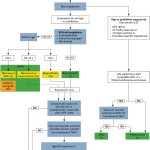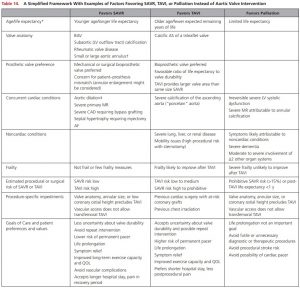Abbreviations
- TTE: Trans-Thoracic Echocardiography
- LVEF: Left Ventricular Ejection Fraction
- AS: Aortic Stenosis
Introduction
- Options of fixing stenotic valves include percutaneous vs. open and valvuloplasty vs. replacement
- Decision should involve a Valve Team and should be individualized to every patient
- Patient profile and technical factors influence decision
- Choosing what type of intervention will be the focus of this article. Diagnosing stenotic lesions and medical therapy are discussed elsewhere.
Aortic Stenosis
Diagnosis
- TTE is indicated to establish diagnosis
- If low-flow low gradient is suspected, low-dose dobutamine stress testing with echo or cardiac catheterization can be done
Criteria
- Severe aortic stenosis is diagnosed by:
- Peak velocity >4 m/s or mean gradient >40 mmHg
- Typically aortic valve area < 1 cm2 but not required to diagnose
- Ancillary findings
- LV diastolic function, LV hypertrophy, and generally normal LVEF, but in late stages EF can drop and LV can dilate
Interventions
Percutaneous Aortic Balloon Dilation
- Mainly used in young patients; limited role in elderly
- Can be used in patients with severe AS and refractory pulmonary edema or cardiogenic shock as a bridge but less common with availability of TAVI
Prosthetic Valve Choice
- Choice of AVR should be based on shared decision making involving the Valve Team and the patient
Assess Risk and Frailty
- High or prohibitive risk patients should go for TAVI or palliation
- Not high risk:
- <50 SAVR (mechanical valve)
- unless contraindication to VKA
- 50-65 SAVR
- Mechanical or bioprosthetic valve
- Highly debated as new bioprosthetic valve more durable
- 65-80 SAVR or TAVI
- >80 TAVI (Class 2 SAVR)
- <50 SAVR (mechanical valve)
Assess TAVI Suitability
- TAVI suitability should be assessed by Valve Team
- Assessment includes valve anatomy, annular size, coronary ostial height (low ostial height precludes TAVI) and vascular access
Decision Making Frameworks
Further Reading
Authors
- Author: Atul Jaidka (MD, FRCPC, Cardiology Fellow)
- Copy Editor: Megha Shetty (MD Candidate)
- Last Updated: April 5, 2021
- Comments or questions please email feedback@cardioguide.ca






